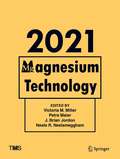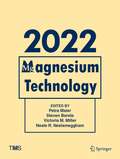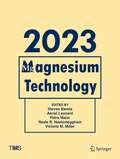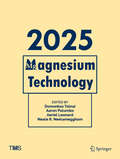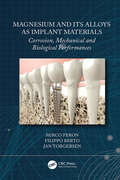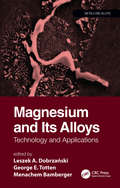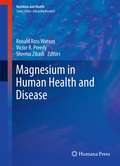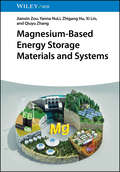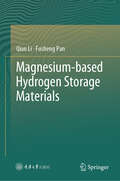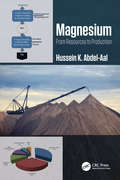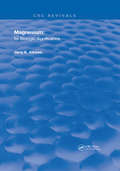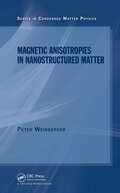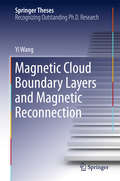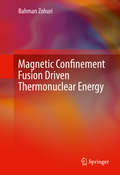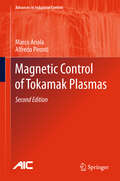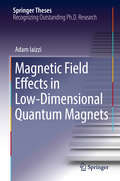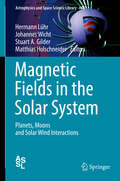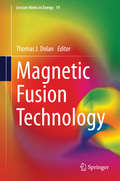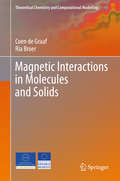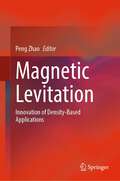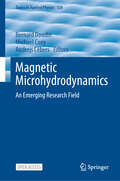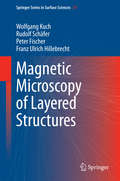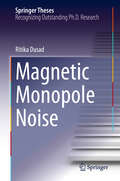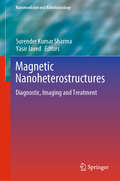- Table View
- List View
Magnesium Technology 2021 (The Minerals, Metals & Materials Series)
by Neale R. Neelameggham J. Brian Jordon Victoria M. Miller Petra MaierThe Magnesium Technology Symposium, the event on which this collection is based, is one of the largest yearly gatherings of magnesium specialists in the world. Papers represent all aspects of the field, ranging from primary production to applications to recycling. Moreover, papers explore everything from basic research findings to industrialization. Magnesium Technology 2021 is a definitive reference that covers a broad spectrum of current topics, including novel extraction techniques; primary production; alloys and their production; thermodynamics and kinetics; cast products and processing; wrought products and processing; forming, joining, and machining; corrosion and surface finishing; structural applications; degradation and biomedical applications; and several others.
Magnesium Technology 2022 (The Minerals, Metals & Materials Series)
by Neale R. Neelameggham Victoria M. Miller Petra Maier Steven BarelaThe Magnesium Technology Symposium at the TMS Annual Meeting & Exhibition is one of the largest yearly gatherings of magnesium specialists in the world. Papers represent all aspects of the field, ranging from primary production to applications and recycling. Moreover, papers explore everything from basic research findings to industrialization. Magnesium Technology 2022 is a definitive reference that covers a broad spectrum of current topics, including novel extraction techniques; primary production; alloys and their production; integrated computational materials engineering; thermodynamics and kinetics; plasticity mechanisms; cast products and processing; wrought products and processing; forming, joining, and machining; corrosion and surface finishing; fatigue and fracture; dynamic response; structural applications; degradation and biomedical applications; emerging applications; additive manufacturing of powders; and recycling, ecological issues, and life cycle analysis.
Magnesium Technology 2023 (The Minerals, Metals & Materials Series)
by Neale R. Neelameggham Victoria M. Miller Petra Maier Steven Barela Aeriel LeonardThe Magnesium Technology Symposium at the TMS Annual Meeting & Exhibition is one of the largest yearly gatherings of magnesium specialists in the world. Papers represent all aspects of the field, ranging from primary production to applications and recycling. Moreover, papers explore everything from basic research findings to industrialization. Magnesium Technology 2023 is a definitive reference that covers a broad spectrum of current topics, including novel extraction techniques; primary production; alloys and their production; integrated computational materials engineering; thermodynamics and kinetics; plasticity mechanisms; cast products and processing; wrought products and processing; forming, joining, and machining; corrosion and surface finishing; fatigue and fracture; dynamic response; structural applications; degradation and biomedical applications; emerging applications; additive manufacturing of powders; and recycling, ecological issues, and life cycle analysis.
Magnesium Technology 2025 (The Minerals, Metals & Materials Series)
by Neale R. Neelameggham Aeriel Leonard Domonkos Tolnai Aaron PalumboThe Magnesium Technology Symposium at the TMS Annual Meeting & Exhibition is one of the largest yearly gatherings of magnesium specialists in the world. Papers represent all aspects of the field, ranging from primary production to applications and recycling. Moreover, papers explore everything from basic research findings to industrialization. Magnesium Technology 2025 is a definitive reference that covers a broad spectrum of current topics, including novel extraction techniques; primary production; alloys and their production; integrated computational materials engineering; thermodynamics and kinetics; plasticity mechanisms; cast products and processing; wrought products and processing; forming, joining, and machining; corrosion and surface finishing; fatigue and fracture; dynamic response; structural applications; degradation and biomedical applications; emerging applications; additive manufacturing of powders; and recycling, ecological issues, and life cycle analysis.
Magnesium and Its Alloys as Implant Materials: Corrosion, Mechanical and Biological Performances
by Mirco Peron Filippo Berto Jan TorgersenDespite their tremendous potential, Mg and its alloys are not yet used in biomedical applications. This book aims to provide scientific insights into the challenges of the materials, and give an overview of the research regarding their mechanical properties, corrosion behaviour and biological performances. The authors intend to put the reader into the position to accurate discern the proper Mg-based material for his/her applications and to choose the proper improvement strategy to his/her cause. To this aim, the manuscript is structured as follow: in Section 2, the main challenges hampering the use of magnesium in biomedical applications and the common improvement strategies are listed. In Section 3, the most investigated Mg alloys are reported in separate sub-sections, detailing their mechanical properties, corrosion behaviour and biotoxicity. High-pure and ultra-high-pure Mg, Al-based Mg alloys, Zn-based Mg alloys, Ca-based alloys and RE-based Mg alloys have been considered. In Section 4, the alloys’ performances with respect to the challenges is summarized providing the reader with useful information and suggestions on the potentially most suited choice. Finally, in Section 5, an outlook portraying the authors’ opinion of the future development of the field will be provided. This book will allow biomedical engineers, surface scientists, material scientists, implant manufacturers and companies working on implant approval an overview of the state-of-the-art technologies adopted so far to overcome the drawbacks of Mg for biomedical applications. Particular emphasis is put on explaining the link between mechanical, corrosion and biocompatible properties of Mg and its alloys as well as their pros and cons. In doing so, the authors intend to put the reader into the position to accurate discern the proper Mg-based material for his/her applications and to choose the proper improvement strategy to his/her cause.
Magnesium and Its Alloys: Technology and Applications (Metals And Alloys Ser.)
by Leszek A. Dobrzański, George E. Totten and Menachem BambergerMagnesium and Its Alloys: Technology and Applications covers a wide scope of topics related to magnesium science and engineering, from manufacturing and production to finishing and applications. This handbook contains thirteen chapters, each contributed by experts in their respective fields, and presents a broad spectrum of new information on pure magnesium, magnesium alloys, and magnesium matrix MgMCs composites. It covers such topics as computational thermodynamics, modern Mg-alloys with enhanced creep or fatigue properties, cutting-edge approaches to melt treating (grain refinement, micro-alloying, and the resulting solidification and growth), coatings, surface engineering, environmental protection (recycling and green energy storage and production), as well as biomedical applications. Aimed at researchers, professionals, and graduate students, the book conveys comprehensive and cutting-edge knowledge on magnesium alloys. It is especially useful to those in the fields of materials engineering, mechanical engineering, manufacturing engineering, and metallurgy.
Magnesium in Human Health and Disease
by Victor R. Preedy Ronald Ross Watson Sherma ZibadiMagnesium is an essential mineral which is required for growth and survival of humans. Since magnesium is a mineral and not synthesizable it must be obtained through dietary foods and/or supplements. Magnesium in Human Health and Disease reviews the benefits of magnesium supplementation to reach recommended intakes as well as provides new research that suggests how reaching levels above the recommended intakes can promote health and treat various diseases. Magnesium deficiency can cause low serum potassium and calcium levels, retention of sodium, and low circulating levels of regulatory hormones. These changes in nutrients cause neurological and muscular symptoms such as tremor and muscle spasms. Further magnesium deficiency causes loss of appetite, nausea, vomiting, personality changes and death from heart failure. Causes of magnesium deficiency include alcohol abuse, poorly controlled diabetes, excessive or chronic vomiting and/or diarrhea. Thus the effects of inadequate and deficient intakes or levels of magnesium is critical to health and are reviewed by the expert clinicians in this book. Magnesium in Human Health and Disease provides the most current research to support the potential benefits or lack thereof for normal and high supplementation with magnesium. Animal model research and early human trials are reviewed to document other disease states such as hypertension, cholesterol level, type 2 diabetes and cardiovascular disease that would benefit from increased magnesium.
Magnesium-Based Energy Storage Materials and Systems
by Xi Lin Jianxin Zou Yanna NuLi Zhigang Hu Qiuyu ZhangUnderstand the energy storage technologies of the future with this groundbreaking guide Magnesium-based materials have revolutionary potential within the field of clean and renewable energy. Their suitability to act as battery and hydrogen storage materials has placed them at the forefront of the world#s most significant research and technological initiatives. It has never been more essential that professionals working in energy storage and energy systems understand these materials and their extraordinary potential applications. Magnesium-Based Energy Storage Materials and Systems provides a thorough introduction to advanced Magnesium (Mg)-based materials, including both Mg-based hydrogen storage and Mg-based batteries. Offering both foundational knowledge and practical applications, including step-by-step device design processes, it also highlights interactions between Mg-based and other materials. The result is an indispensable guide to a groundbreaking set of renewable energy resources. Magnesium-Based Energy Storage Materials and Systems readers will also find: In-depth analysis of the effects of employing catalysts, nano-structuring Magnesium-based materials, and many more subjects Detailed discussion of electrolyte, cathode, and anode materials for Magnesium batteries Snapshots of in-progress areas of research and development Magnesium-Based Energy Storage Materials and Systems is ideal for materials scientists, inorganic chemists, solid state chemists, electrochemists, and chemical engineers.
Magnesium-based Hydrogen Storage Materials
by Qian Li Fusheng PanThis book summarizes the thermodynamics and kinetics of Mg-based storage materials and introduces recent progress, including alloying, adding catalysts/composites and nanosizing on Mg-based hydrogen storage materials. The content describes the fundamental theories of hydrogen storage materials and reviews the key achievements in applications. The targeted audience of this book includes scientific/engineering researchers, technicians, lectures, entrepreneurs, and investors at all levels related to hydrogen energy, materials, chemicals, etc. This book can also be used as a textbook for senior undergraduate and postgraduate students in hydrogen energy, materials, and chemical engineering.
Magnesium: From Resources To Production
by Hussein K. Abdel-AalMagnesium is one of the most abundant minerals in seawater. Extracting magnesium from seawater could reduce cost of this mineral, resulting in positive implications for industries that use it. This book addresses mineral process engineering with emphasis on magnesium and provides practicing engineers and students with comprehensive knowledge on magnesium and how it is extracted from seawater and magnesium ores. It takes a chemical engineering approach as separation of magnesium from seawater involves the application of the powerful science of chemistry and transport phenomena principles. This monograph discusses magnesium resources and occurrence, includes an exploration study on deriving magnesium and mineral salts from seawater, and features coverage of magnesium chloride. It also covers commercial methods for magnesium production as an end product, current and prospective applications in the energy domain, and offers an account of the use of magnesium to store hydrogen in the form of magnesium hydride.
Magnesium: It's Biologic Significance (Routledge Revivals)
by Jerry K. AikawaFirst Published in 1981, this book offers a full, comprehensive guide into the aspects of magnesium and its effect on our bodies, ecosystem, and much more. Carefully compiled and filled with a vast repertoire of notes and references this book is a useful reference for Dieticians, Physicians, and Students in their respective fields.
Magnetic Anisotropies in Nanostructured Matter (Condensed Matter Physics)
by Peter WeinbergerOne of the Top Selling Physics Books according to YBP Library ServicesMagnetic Anisotropies in Nanostructured Matter presents a compact summary of all the theoretical means to describe magnetic anisotropies and interlayer exchange coupling in nanosystems. The applications include free and capped magnetic surfaces, magnetic atoms on metallic substra
Magnetic Cloud Boundary Layers and Magnetic Reconnection
by Yi WangThis thesis focuses on magnetic reconnection processes in the boundary layer of the interplanetary magnetic cloud. Magnetic reconnection is an important and frontier topic in the realm of physics. Various physical phenomena can be observed during the reconnection process but lots of them are not fully understood. This thesis provides the first observational evidence of energetic electrons associated with magnetic reconnection in the solar wind and discusses the particle acceleration problems. In addition, after analyzing the particle flux variations in Magnetic Cloud Boundary Layer, the thesis proposes a possible new criterion for the identification of magnetic reconnection in the solar wind. These tantalizing results could be particular clues to understand the dynamical problems in magnetic reconnection processes.
Magnetic Confinement Fusion Driven Thermonuclear Energy
by Bahman ZohuriThis book covers the principles and practices behind the Magnetic Confinement Fusion (MCF) approach to driven new source of energy. All possible technical methods, including well established theoretical research, as well as findings tested in an experimental tokamak reactor, are examined in order to determine how to best achieve breakeven via this pathway to plasma-driven fusion. The author undertakes a life cycle analysis to compare and contrast the efficiency, environmental impacts, and operating costs of plasma-driven MCF fusion against other forms of energy generation currently in widespread use. The associated computer code and numerical analysis are included in the book. No prior knowledge of MCF and no more than basic background in plasma physics is required.
Magnetic Control of Tokamak Plasmas
by Marco Ariola Alfredo PirontiThis book is a complete treatment of work done to resolve the problems of position-, current-, and shape-control of plasma in tokamak-type (toroidal) devices being studied as a potential means of commercial energy production by nuclear fusion. Modelling and control are both detailed, allowing non-expert readers to understand the control problem. Starting from the magneto-hydro-dynamic equations, all the steps needed for the derivation of plasma state-space models are enumerated with frequent recall of the basic concepts of electromagnetics. The control problem is then described, beginning with the control of current and position--vertical and radial--control and progressing to the more challenging shape control. The solutions proposed vary from simple PIDs to more sophisticated MIMO controllers. The second edition of Magnetic Control of Tokamak Plasmas contains numerous updates and a substantial amount of completely new material covering areas such as: * modelling and control of resistive wall modes--the most important non-axisimmetric mode; * the isoflux approach for shape control; * a general approach for the control of limiter plasmas; * the use of inner vessel coils for vertical stabilization; and * significantly enhanced treatment of plasma-shape control at JET, including experimental results and introducing a method implemented for operation in the presence of current saturations. Whenever possible, coverage of the various topics is rounded out with experimental results obtained on currently existing tokamaks. The book also includes a presentation of the typical actuators and sensors used for control purposes in tokamaks. Some mathematical details are given in the appendices for the interested reader. The ideas formulated in this monograph will be of great practical help to control engineers, academic researchers and graduate students working directly with problems related to the control of nuclear fusion. They will also stimulate control researchers interested more generally in the advanced applications of the discipline. Advances in Industrial Control aims to report and encourage the transfer of technology in control engineering. The rapid development of control technology has an impact on all areas of the control discipline. The series offers an opportunity for researchers to present an extended exposition of new work in all aspects of industrial control.
Magnetic Dynamics in Antiferromagnetically-Coupled Ferrimagnets: The Role of Angular Momentum (Springer Theses)
by Takaya OkunoThis book presents the theoretical and experimental investigations on antiferromagnetically coupled ferrimagnets and reveals new aspects of ferrimagnetic dynamics in terms of the role of angular momentum. The purpose of this book is to show readers that antiferromagnets/ferrimagnets are useful in spintronic devices in that (1) The nonadiabatic spintransfer torque in antiferromagnets acts as a staggered magnetic field, which can drive the magnetic domain walls, and (2) The Gilbert damping parameter α, the energy dissipation rate associated with the magnetic dynamics of ferrimagnets, is insensitive to temperature in contrast to the conventional understanding that the effective α of ferrimagnets diverges at the angular momentum compensation temperature. This book provides readers with a scientific platform of ferrimagnetic dynamics, which serves as a useful basis for realizing the next generation of spintronic devices.
Magnetic Field Effects in Low-Dimensional Quantum Magnets (Springer Theses)
by Adam IaizziThis thesis is a tour-de-force combination of analytic and computational results clarifying and resolving important questions about the nature of quantum phase transitions in one- and two-dimensional magnetic systems. The author presents a comprehensive study of a low-dimensional spin-half quantum antiferromagnet (the J-Q model) in the presence of a magnetic field in both one and two dimensions, demonstrating the causes of metamagnetism in such systems and providing direct evidence of fractionalized excitations near the deconfined quantum critical point. In addition to describing significant new research results, this thesis also provides the non-expert with a clear understanding of the nature and importance of computational physics and its role in condensed matter physics as well as the nature of phase transitions, both classical and quantum. It also contains an elegant and detailed but accessible summary of the methods used in the thesis—exact diagonalization, Monte Carlo, quantum Monte Carlo and the stochastic series expansion—that will serve as a valuable pedagogical introduction to students beginning in this field.
Magnetic Fields in the Solar System: Planets, Moons and Solar Wind Interactions (Astrophysics and Space Science Library #448)
by Hermann Lühr Johannes Wicht Stuart A. Gilder Matthias HolschneiderThis book addresses and reviews many of the still little understood questions related to the processes underlying planetary magnetic fields and their interaction with the solar wind. With focus on research carried out within the German Priority Program "PlanetMag", it also provides an overview of the most recent research in the field. Magnetic fields play an important role in making a planet habitable by protecting the environment from the solar wind. Without the geomagnetic field, for example, life on Earth as we know it would not be possible. And results from recent space missions to Mars and Venus strongly indicate that planetary magnetic fields play a vital role in preventing atmospheric erosion by the solar wind. However, very little is known about the underlying interaction between the solar wind and a planet's magnetic field. The book takes a synergistic interdisciplinary approach that combines newly developed tools for data acquisition and analysis, computer simulations of planetary interiors and dynamos, models of solar wind interaction, measurement of ancient terrestrial rocks and meteorites, and laboratory investigations.
Magnetic Fusion Technology
by Thomas J. DolanMagnetic Fusion Technology describes the technologies that are required for successful development of nuclear fusion power plants using strong magnetic fields. These technologies include: * magnet systems, * plasma heating systems, * control systems, * energy conversion systems, * advanced materials development, * vacuum systems, * cryogenic systems, * plasma diagnostics, * safety systems, and * power plant design studies. Magnetic Fusion Technology will be useful to students and to specialists working in energy research.
Magnetic Interactions in Molecules and Solids
by Coen Graaf Ria BroerThis textbook is the second volume in the Theoretical Chemistry and Computational Modeling series and aims to explain the theoretical basis of magnetic interactions at a level that will be useful for master students in physical, inorganic and organic chemistry. The book gives a treatment of magnetic interactions in terms of the phenomenological spin Hamiltonians that have been such powerful tools for chemistry and physics in the past half century, starting from the simple Heisenberg and Ising Hamiltonians and ending with Hamiltonians that include biquadratic, cyclic or anisotropic exchange. On the other hand, it also explains how quantum chemical methods, reaching from simple mean field methods to accurate models that include the effects of electron correlation and spin-orbit coupling, can help to understand the magnetic properties. Connecting the two perspectives is an essential aspect of the book, since it leads to a deeper understanding of the relation between physical phenomena and basic properties. It also makes clear that in many cases one can derive magnetic coupling parameters not only from experiment, but also from accurate ab initio calculations. The book starts with introducing a selection of basic concepts and tools. Throughout the book the text is interlarded with exercises, stimulating the students to not only read but also verify the assertions and perform (parts of) the derivations by themselves. In addition, each chapter ends with a number of problems that can be used to check whether the material has been understood.
Magnetic Levitation: Innovation of Density-Based Applications
by Peng ZhaoThis book introduces the MagLev testing method for density measurement and density-based applications of diamagnetic and low-magnetic objects using permanent magnets. The book surveys the most relevant papers on the theory and model of various MagLev methods that have become the foundation to elucidate the principles of MagLev and the conditions for stable levitation. A thorough summary of the improvements demonstrates the applications and potential of the MagLev method in many fields. This book is separated into 11 chapters to present MagLev testing method fully, including a review of the background of MagLev, theories and basic principles of the stable levitation of object, different dimensions of applications of MagLev in the fields of mechanical engineering, chemistry, and bioengineering, and sophisticated applications of manipulation and separation. This book would benefit the audience in the field of mechanical engineering, chemistry, materials science, and bioengineering, since magnetic levitation method has proved itself suitable for the density-based analysis and applications of materials of different scales. The analysis in this book will help the audience deeply understand the mechanism of magnetic levitation, and it can serve as an instruction for the magnetic levitation procedure, or guidebook for the magnetic levitation setup. With the viewpoints and thoughts about MagLev running through this book, this book may spark the audience’s interest towards magnetic levitation method, and enlighten them to further develop Maglev method.
Magnetic Microhydrodynamics: An Emerging Research Field (Topics in Applied Physics #120)
by Bernard Doudin Michael Coey Andrejs CēbersThis open access book presents the most recent advances in the novel, interdisciplinary field of magnetic microhydrodynamics. This emerging area of advanced research combines magnetism with the knowledge of bioinspired local flow control to create novel concepts and technological solutions that could revolutionize the field of microfluidics. Edited and authored by world-recognized leaders in this field, this book covers how the action of magnetic forces on soft matter can result in a richness of possible static and dynamic behavior. The contributions featured in this book introduce timely examples of novel concepts (new fluids and control), processes at interfaces (local probes, electrochemistry), and applications of magnetic soft matter in cell biology, cargo transport, and energy. This book is of great interest to scientists from various backgrounds looking to explore, learn of recent developments, and take part in laying the foundations of an entirely new and dynamic field of research.
Magnetic Microscopy of Layered Structures
by Peter Fischer Wolfgang Kuch Rudolf Schäfer Franz Ulrich HillebrechtThis book presents the important analytical technique of magnetic microscopy. This method is applied to analyze layered structures with high resolution. This book presents a number of layer-resolving magnetic imaging techniques that have evolved recently. Many exciting new developments in magnetism rely on the ability to independently control the magnetization in two or more magnetic layers in micro- or nanostructures. This in turn requires techniques with the appropriate spatial resolution and magnetic sensitivity. The book begins with an introductory overview, explains then the principles of the various techniques and gives guidance to their use. Selected examples demonstrate the specific strengths of each method. Thus the book is a valuable resource for all scientists and practitioners investigating and applying magnetic layered structures.
Magnetic Monopole Noise (Springer Theses)
by Ritika DusadThis thesis presents the first ever measurement of the noise emitted by magnetic monopoles and the development of an exquisitely sensitive magnetic-field-noise spectrometer based on a superconducting quantum interference device (SQUID) that enabled it. Magnetic monopoles are highly elusive elementary particles exhibiting quantized magnetic charge. The prospects for studying them brightened recently with the theoretical discovery that the thermally excited states in certain classes of magnetic insulators exhibit all the characteristics of magnetic monopoles. Furthermore, in 2018, it was predicted that the random motion of magnetic monopoles inside would generate a very specific kind of magnetization noise. In this thesis, the author describes a new experimental technique, so-called spin noise spectroscopy, and the subsequent discovery of virtually all of the predicted features of the magnetic noise expected from a dense fluid of magnetic monopoles in crystals of Dy2Ti2O7. Remarkably, because this magnetic monopole noise occurs in the frequency range below 20kHz, when amplified by the SQUID it is actually audible to humans.
Magnetic Nanoheterostructures: Diagnostic, Imaging and Treatment (Nanomedicine and Nanotoxicology)
by Surender Kumar Sharma Yasir JavedThis book contains most updated information on synthesis of magnetic nanohybrids, their physio-chemical properties, and key biological applications. It highlights the complexity of nanoheterostructures, especially magnetic metal oxides, ferrites and doped magnetic nanomaterials, and discusses their potential applications in the early detection, imaging and treatment of cancer. It also covers the toxicity and risk assessment of multifunctional nanomaterials. Providing an overview of magnetic nanoheterostructures, it appeals to a wide audience, from beginners and graduate-level students to experts in academia and industry.
